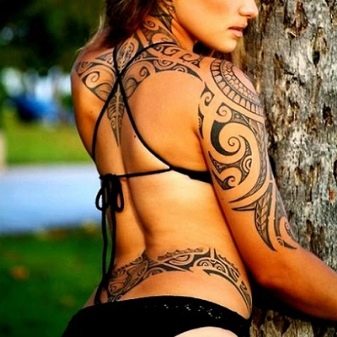Maori tattoo: meaning and interesting options
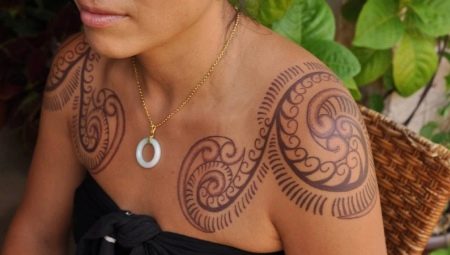
Maori style tattoos for men and women can be attributed to a group of ethnic ornaments popular among the indigenous New Zealand peoples. Each line in the sketch, detail of the image here has its own meaning - it is better to study the symbolism in advance so as not to get into an awkward position. A detailed review will help you find out what typical Maori tattoos look like on an arm or leg, and will allow you to make the right choice of ornament for applying on the back, face, chest.
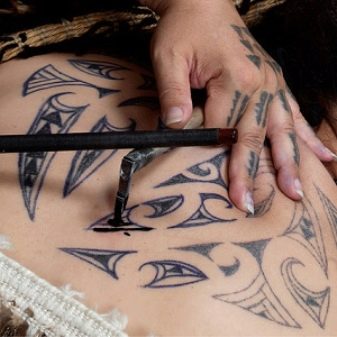
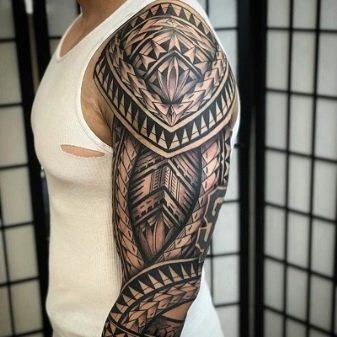
Meaning
A tattoo in the style of the Maori tribe is fully consistent with the warlike spirit of the representatives of this ethnic group. In almost all elements of their folk art, there is a spiral, which has different versions. Traditionally, tattoos were applied to the faces and bodies of prominent members of the tribe - leaders, valiant warriors. This work was carried out manually by men and women, and the ta-moko ornament was formed on the skin not with the help of needles, but due to its scarification using a miniature chisel.
Traditional Maori tattoos migrated to the European continent from New Zealand, but have not lost their original meaning. For example, symbols on the face in the chin area meant that their owner had reached the age of majority. And complemented by ornaments around the mouth, they testified to his high position in society.
Several elements of Maori tattoos indicated the combat experience of their wearer. New drawings were added throughout life.
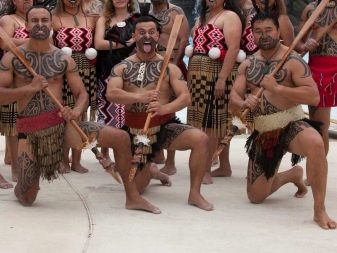
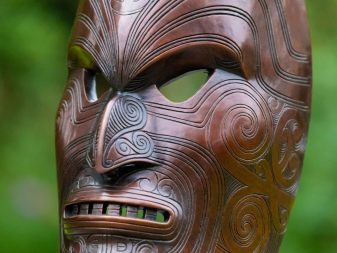
Maori could literally read each other's "book of life" from their tattoos. The absence of drawings on the body was equated with godlessness, such a person could not be considered equal to his fellow tribesmen.
The location of the drawing could tell a lot about the Maori.
- Ornaments were applied to the foreheads of the soldiers.
- The area around the eyes.According to her, they read the "pedigree": on the left - on the paternal side, on the right - on the maternal side.
- On the cheeks, they made patterns related to the type of human activity.
- The temples were tattooed with Uma, indicating marital status. If there was more than one marriage, the sign was repeated.
- Under his nose was the personal signature of a member of the tribe - Raurau.
- Wairua was placed on the chin area. This mark denoted the class to which the Maori belonged.
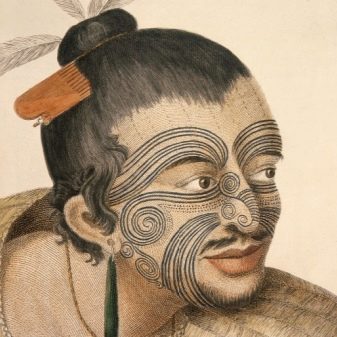

The color scheme of the tattoos is fairly neutral. Usually the ornament remains monochromatic and is painted black with special pigments. Since the climate in the Maori lands was far from ideal due to the abrupt change of seasons, the application of patterns on the face was considered a priority.
These lines replaced the usual documents, made it possible to read the biography of a fellow tribesman at a meeting, like an open book.
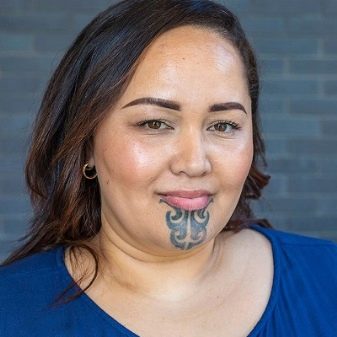

Species overview
Ethnicity is usually quite stingy with symbolism. Polynesia and New Zealand, whose indigenous peoples have close family ties, have many common traditions in the choice of ornaments for tattoos. It has its own classic motives, but the division of images into women and men is not made.... The lines of the patterns are massive, wide, often encircling the wrist or ankle, and the upper part of the hand.


Animals
Animalistic motives are not very typical for Maori. Nevertheless, this tribe has its own "patrons", the properties of which the warriors or leaders wanted to acquire. The meaning of these protective totems, applied to the human body, is usually read as follows.
- Stingray... A powerful protective amulet that protects against negativity.
- Shark... A very powerful talisman. Such a tattoo marked the most fearless warriors who never succumbed to enemies.
- Dolphin... It was considered a talisman against attacks by predators at sea. Also, the image of this sea animal characterizes a person as a cheerful nature, a good friend.
- Whale... This totem was also used as a protective symbol by people who regularly went out to fight the ocean waves. The lord of the seas provided reliable protection from predators.
- Turtle... It was applied to the shoulder of hot-tempered people, as well as warriors as a symbol of life extension.
- Bird... It denotes freedom and fearlessness, the willingness to fight for justice. Interestingly, the Maori often imitated the plumage of birds in their ornaments, covering their shoulders, arms, and chest.
- Bull... This ornament began to be used at a time when the warlike people switched from their traditional occupations to a peaceful lifestyle. For farmers, strong and stubborn animals have become a symbol of the new era.
- Lizard... This sign was worn on the body by people who are perspicacious, intelligent, who want to discover the gift of foresight in themselves.
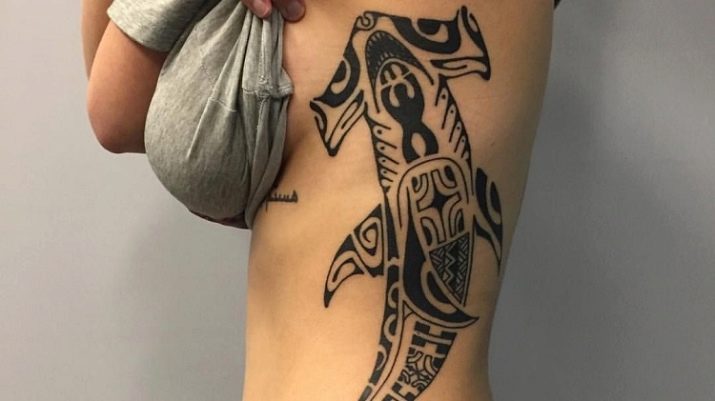
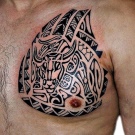
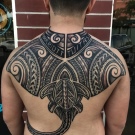

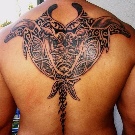
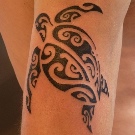
Each animal had a sacred meaning in the Maori culture. That is why the inhabitants of New Zealand and Oceania carefully selected patrons for themselves. Sometimes a bear is proposed as a totem in this style in modern tattoo parlors.
It's just quite difficult to meet this animal on the territory of Oceania. Rather, we are talking about Russified stylization, which is passed off as an original ornament.
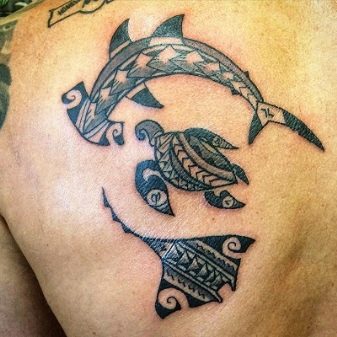
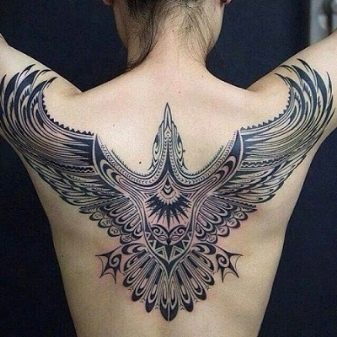
Masks
Initially, this ornament was exclusively the privilege of the warrior. In the Maori dialect, masks are called tics... Most often, this symbol was considered as a talisman, as well as a means to intimidate enemies. Masks were applied to the shoulders, chest, knee, and when a person moved, they "came to life", terrifying those around them with realistic facial expressions.
Tiki, according to Maori legends, is the first man, the one from whom this people originated. That is why the mask has the characteristic features of an embryo with a hypertrophied large head and frightening facial features.
It is the tics applied to the bodies of Europeans that annoy the proud people today most of all. After all, the mask is a symbol of the Maori, its progenitor, and not just entertainment for bored tourists.
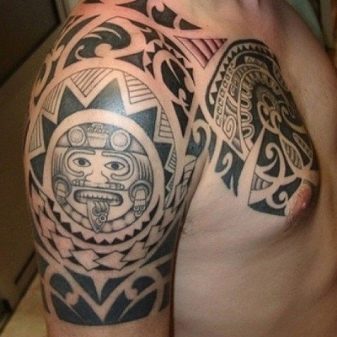
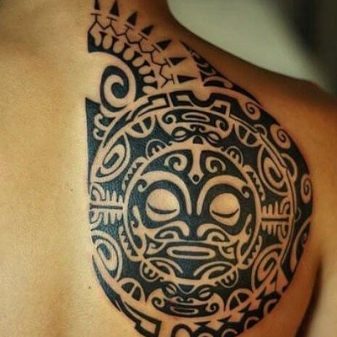
Patterns and ornaments
Symmetrical spirals are one of the main geometric shapes in the tattoos of the Maori people. They are distinguished by the clarity of the curls, the complexity and uniqueness of the pattern. In the tradition of the peoples of Polynesia, male warriors often wore this ornament on the buttocks and thighs. The Maori spirals are closed, with 2 or 3 twists, in their appearance they resemble an infinity sign. Sometimes the end of this sign looks like a fish hook.
Another repeating geometric element - trapezoid, symbolizing the sharp tip of a battle ax. It could mean both the fact that a person works with wood, and also indicate a completely not peaceful lifestyle of its owner. The leaders wore an ax as a symbol of power on their bodies.
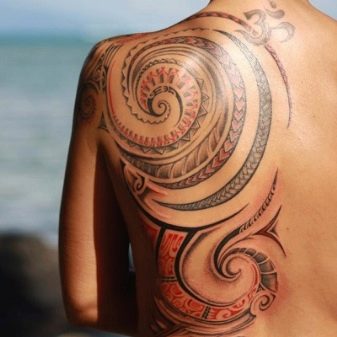

Symbols of nature
Among the images associated with the world around, the Maori style is best suited to the shining disk of the heavenly body... The sun has a special meaning here. In their tattoos, members of this tribe used it to glorify good. Also Sun denotes the unchanging connection between life and death.
Another type of natural ornament is wave... For the inhabitants of lands surrounded by an endless ocean, this symbol is quite typical. Submitting to the will of the waves, the Maori preferred to play it safe. The symbol of the water element protected them during the extraction of food in the ocean.
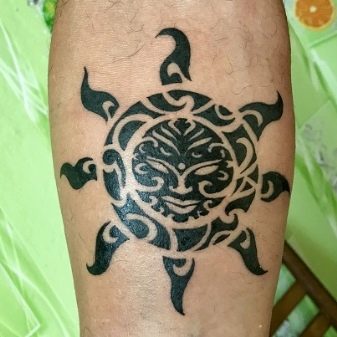
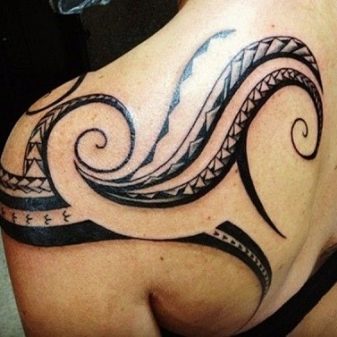
Where can I stuff?
For the New Zealand Maori tribe, the choice of tattoo designs has always been driven by human anatomy. There were symmetrical patterns on the face that looked harmonious and strict. On the body for tattoos, the areas of the legs, shoulders, and other areas not hidden under clothing were selected.
When creating modern ornaments, stylized with Maori motives, men and women most often choose the following options:
- symmetrical frames on the face around the mouth;
- unilateral spirals on the neck;
- "Sleeve" on the forearm with transition to the chest;
- paired elements on the back and shoulder blades;
- concentric circles on the back of the lower leg.
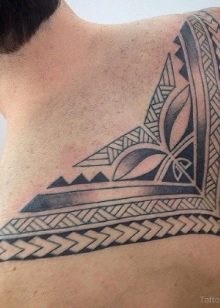
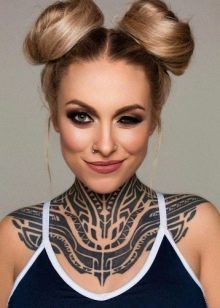

Also in the Maori style, ornaments in the form of a male bracelet on the arm or leg. It is customary to tattoo the eyebrows and the area around the eyes on the face, and the protruding parts of the cheekbones. Ornaments look so harmonious that girls often choose them for themselves. Moreover, they apply not only relatively neutral patterns on the chest, but also recreate typical patterns on the chin.
True Maori tattoos always cover most of the body surface. In modern society, this is unlikely to be appropriate. Tattoos are hidden under office suits and long-sleeved shirts, under strict blouses. Not every European will dare to apply Maori ornaments on the face.
Girls and women prefer to decorate the back of the neck, the surface under the collarbones or on the ankles with such patterns.

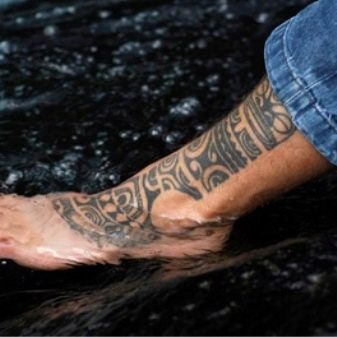
Beautiful examples
Not every New Zealand tribal tattoo sketch matches the Maori aesthetic. Since this style is close to Polynesian, it is rather difficult to distinguish between them. And yet, looking at examples of finished works, one can understand why these ornaments are so attractive.
- Tattoo on the lower leg in the form bracelet, encircling the entire leg in a circle, includes several different types of images at once. There are masks enclosed in circles, curls, waves and triangles. Geometric elements intertwine in a complex pattern, emphasizing the natural structure of the human body.

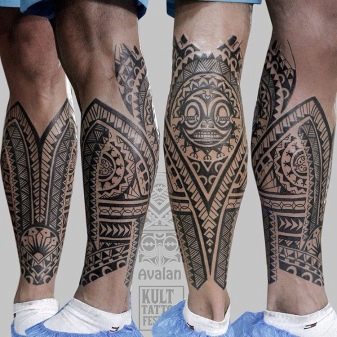
- Typical tattoo in Maori aesthetics for a man. The chosen ornament reminds of a bird's wing - cloaks with feathers were once worn for disguise by the warriors of the tribe. Needless to say, such a tattoo looks very impressive on a toned and well-developed body.
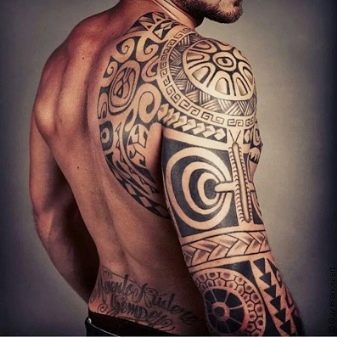
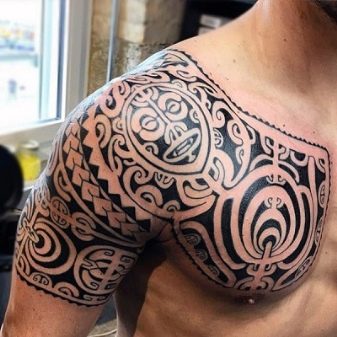
- The traditional ta-moco pattern in modern design looks very harmonious on a woman's body. The ornament occupies the back of the neck and back above the shoulder blades and between them, passes to the right shoulder, covers the lower back. Such a pattern on the skin looks very impressive.
